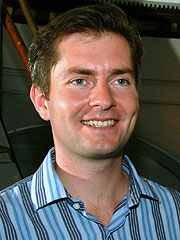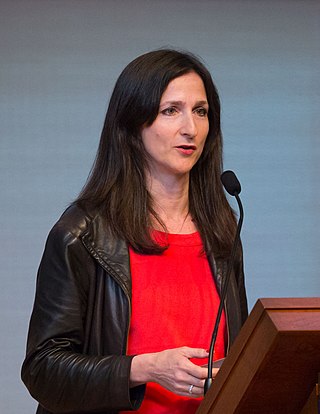
HD 209458 b is an exoplanet that orbits the solar analog HD 209458 in the constellation Pegasus, some 157 light-years from the Solar System. The radius of the planet's orbit is 0.047 AU, or one-eighth the radius of Mercury's orbit. This small radius results in a year that is 3.5 Earth-days long and an estimated surface temperature of about 1,000 °C. Its mass is 220 times that of Earth and its volume is some 2.5 times greater than that of Jupiter. The high mass and volume of HD 209458 b indicate that it is a gas giant.

David Brian Charbonneau is a professor of Astronomy at Harvard University. His research focuses on the development of novel techniques for the detection and characterization of exoplanets orbiting nearby, Sun-like stars.

Sara Seager is a Canadian–American astronomer and planetary scientist. She is a professor at the Massachusetts Institute of Technology and is known for her work on extrasolar planets and their atmospheres. She is the author of two textbooks on these topics, and has been recognized for her research by Popular Science, Discover Magazine, Nature, and TIME Magazine. Seager was awarded a MacArthur Fellowship in 2013 citing her theoretical work on detecting chemical signatures on exoplanet atmospheres and developing low-cost space observatories to observe planetary transits.

Gliese 436 b is a Neptune-sized exoplanet orbiting the red dwarf Gliese 436. It was the first hot Neptune discovered with certainty and was among the smallest-known transiting planets in mass and radius, until the much smaller Kepler exoplanet discoveries began circa 2010.
HD 156668 is a star in the northern constellation of Hercules constellation. With an apparent visual magnitude of 8.4 it is too faint to be viewed with the naked eye, but it can be seen with even a small telescope. The distance to this object has been determined directly using the parallax technique, yielding a value of about 80 light-years.

The NASA Exoplanet Archive is an online astronomical exoplanet catalog and data service that collects and serves public data that support the search for and characterization of extra-solar planets (exoplanets) and their host stars. It is part of the Infrared Processing and Analysis Center and is on the campus of the California Institute of Technology (Caltech) in Pasadena, CA. The archive is funded by NASA and was launched in early December 2011 by the NASA Exoplanet Science Institute as part of NASA's Exoplanet Exploration Program. In June 2019, the archive's collection of confirmed exoplanets surpassed 4,000.

William J. (Bill) Borucki is a space scientist who worked at the NASA Ames Research Center. Upon joining NASA in 1962, Borucki joined the group conducting research on the heat shield for Apollo program spacecraft. He later turned his attention to the optical efficiency of lightning strikes in the atmospheres of planets, investigating the propensity that these lightning strikes could create molecules that would later become the precursors for life. Subsequently, Borucki's attention turned to extrasolar planets and their detection, particularly through the transit method. In light of this work, Borucki was named the principal investigator for NASA's Kepler mission, launched on March 7, 2009 and dedicated to a transit-based search for habitable planets. In 2013, Borucki was awarded the United States National Academy of Sciences's Henry Draper Medal for his work with Kepler. In 2015 he received the Shaw Prize in Astronomy.
Sarah Dodson-Robinson is an American astronomer known for her work on planet formation and an associate professor of physics and astronomy at the University of Delaware.
Kristen Sellgren is an American retired astronomer and Professor Emerita at the College of Natural and Mathematical Sciences, Ohio State University. She won the Newton Lacy Pierce Prize in Astronomy in 1990. She is the founder of American Astronomical Society's Committee for Sexual-Orientation & Gender Minorities in Astronomy (SGMA).
Nadia Zakamska is a Russian-American astronomer who is a professor at Johns Hopkins University.

Stephen Kane is a full professor of astronomy and planetary astrophysics at the University of California, Riverside who specializes in exoplanetary science. His work covers a broad range of exoplanet detection methods, including the microlensing, transit, radial velocity, and imaging techniques. He is a leading expert on the topic of planetary habitability and the habitable zone of planetary systems. He has published hundreds of peer reviewed scientific papers and has discovered/co-discovered several hundred planets orbiting other stars. He is a prolific advocate of interdisciplinarity science and studying Venus as an exoplanet analog.
Harriet Dinerstein is an American astronomer. The American Astronomical Society honored her work by awarding her the Annie J. Cannon Prize in 1985. She also received the Newton Lacy Pierce Prize in 1989. Dinerstein received her Bachelor of Science degree from Yale University in 1975 and her Ph.D. from the University of California, Santa Cruz in 1980. She currently is a Professor of Astronomy at the University of Texas at Austin.
Rebekah Dawson is an American astrophysicist and an associate professor of astronomy and astrophysics at Pennsylvania State University. Her research focuses on simulating the evolution of exoplanetary orbits and compositions to better understand how planetary systems form.

Giovanna Tinetti is an Italian physicist based in London. She is a Professor of Physics and Astronomy at University College London, who researches galactic planetary science, exoplanets and atmospheric science.

Jessie Christiansen is an Australian astrophysicist working at the NASA Exoplanet Science Institute at the California Institute of Technology (Caltech). She won the 2018 NASA Exceptional Engineering Achievement Medal for her work on the Kepler planet sample.
GJ 3470 is a red dwarf star located in the constellation of Cancer, 96 light-years away from Earth. With a faint apparent magnitude of 12.3, it is not visible to the naked eye. It hosts one known exoplanet.
Eric Agol is an American astronomer and astrophysicist who was awarded a Guggenheim Fellowship in 2017.
Caroline Morley is an American scientist, teacher and astronomer researching exoplanet atmosphere science.

Laura Kreidberg is an American astronomer who primarily studies exoplanets. Since 2020, she has been director at the Max Planck Institute for Astronomy (MPIA) in Heidelberg, where she is leading the Atmospheric Physics of Exoplanets (APEx) department. She is MPIA's managing director as of January 2024.











